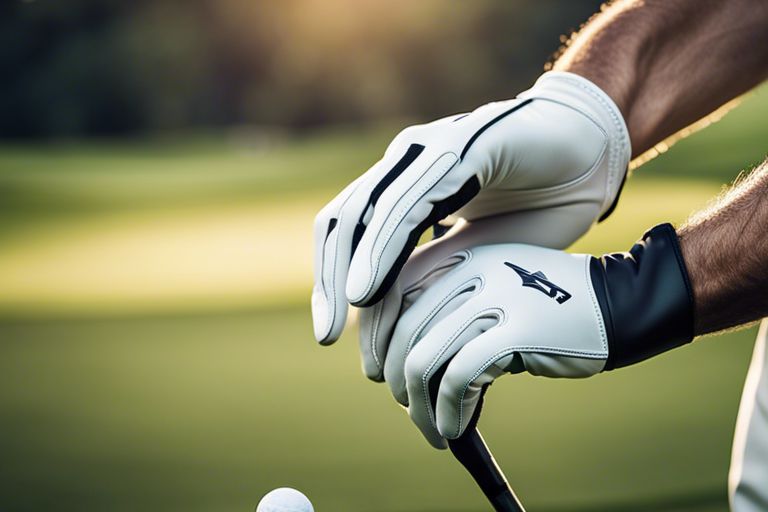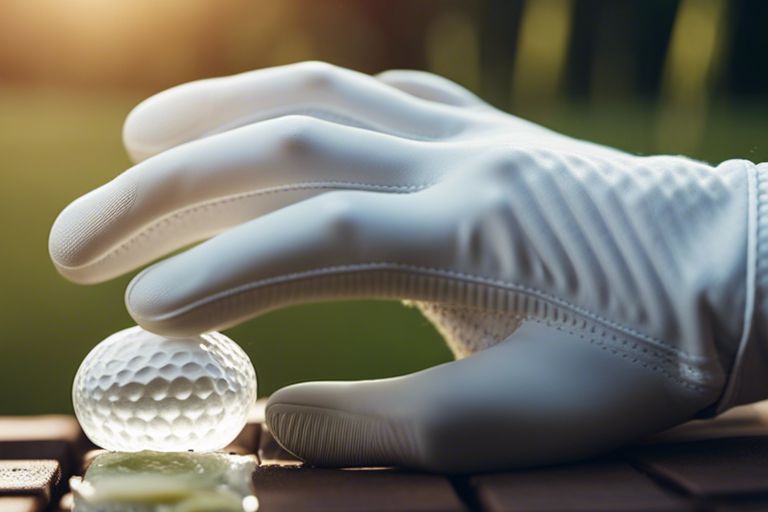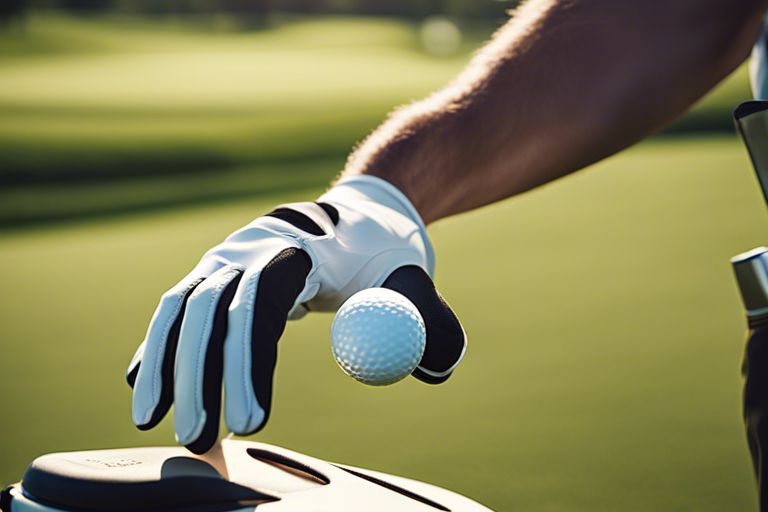There’s a lot more to golf gloves than meets the eye. Have you ever wondered what materials go into making this key piece of golf equipment? From the durable leather to the breathable synthetic fabrics, understanding what golf gloves are made of can help you choose the perfect pair for your game. Let’s explore the materials that make up these necessary accessories for your round on the course.

Key Takeaways:
- Leather: Most golf gloves are made from leather, which provides a good grip, comfort, and durability.
- Synthetic Materials: Some golf gloves are made from synthetic materials like polyester, spandex, or mesh for breathability and flexibility.
- Cabretta Leather: The highest quality golf gloves are often made from cabretta leather, known for its softness, durability, and excellent feel.

Materials Used
Synthetic Materials
For synthetic materials, golf gloves are typically made of materials like polyester, nylon, or a combination of both. These materials are chosen for their durability, flexibility, and ability to wick moisture away from your skin during your swing.
Natural Materials
The most common natural material used in golf gloves is leather, specifically cabretta leather. This type of leather comes from sheepskin and is known for its softness, durability, and ability to provide a good grip on the club.
The use of natural materials like cabretta leather adds a touch of luxury to your golf glove while also ensuring its functionality. This material molds to your hand over time, providing a custom fit that enhances your comfort and performance on the course.
Another natural material sometimes used in golf gloves is deerskin. Deerskin is prized for its suppleness and durability, making it a popular choice among golfers looking for a high-quality glove.

Leather Golf Gloves
Little is better than slipping on a high-quality leather golf glove before teeing off on the course. The feel, grip, and durability of leather make it a popular choice among golfers of all skill levels. Regarding leather gloves, not all are created equal. Different types of leather offer varying levels of comfort, performance, and longevity.
Types of Leather Used
- Full-grain leather
- Cabretta leather
- Synthetic leather
- Sheepskin leather
- Composite leather
Assume that each type of leather has its unique characteristics and benefits, such as softness, flexibility, grip, and moisture-wicking properties. It’s important to choose a leather golf glove that suits your playing style and preferences.
| Golf | Leather |
| Full-grain leather | Durable and offers excellent grip |
| Cabretta leather | Soft and provides a natural feel |
| Synthetic leather | Easy to clean and maintain |
| Sheepskin leather | Offers great comfort and breathability |
| Composite leather | Combines various materials for enhanced performance |
Benefits of Leather Gloves
Leather golf gloves have several advantages over other materials. They provide a superior grip on the club, enhancing your control and accuracy during swings. Additionally, leather gloves mold to your hand over time, offering a customized fit that improves comfort and performance on the course.
Benefits: Not only do leather gloves look stylish, but they also offer durability, breathability, and protection from blisters. Their natural properties make them an excellent choice for golfers looking for a high-performing and comfortable glove.
Fabric Golf Gloves
After leather, fabric is one of the most common materials used to make golf gloves. Fabric gloves are popular among golfers for their breathability and flexibility on the course. Additionally, fabric gloves are typically more affordable than leather gloves, making them a budget-friendly option for many players.
Types of Fabric Used
- Nylon: Lightweight and durable, nylon fabric gloves offer excellent breathability and flexibility.
- Synthetic blends: Combining materials like spandex, polyester, and lycra, synthetic fabric gloves provide a snug fit and moisture-wicking properties.
- Cotton: Soft and comfortable, cotton fabric gloves are a popular choice for golfers who prefer a more traditional feel.
- Polyester: Known for its durability and colorfastness, polyester fabric gloves are long-lasting and easy to care for.
- Mesh: Perfect for hot weather conditions, mesh fabric gloves offer maximum breathability and ventilation.
Perceiving your specific needs and preferences will help you determine the best type of fabric golf glove for your game.
Advantages of Fabric Gloves
One of the main advantages of fabric gloves is their breathability. Fabric gloves allow air to circulate around your hand, preventing sweat buildup and keeping your hand dry and comfortable during your round. Additionally, fabric gloves are typically more lightweight and flexible than leather gloves, providing a snug fit and allowing for better dexterity in your grip and swing.
A proper fit is vital for a golf glove to perform effectively. A fabric glove that fits well will feel like a second skin, enhancing your connection to the club and improving your overall performance on the course.
Waterproofing and Breathability
Membrane Technology
The waterproofing and breathability of golf gloves often come from advanced membrane technology. The membrane is a thin layer inserted between the outer shell and the inside lining of the glove. This membrane is designed to repel water from the outside while allowing moisture (sweat) to escape from the inside, keeping your hands dry and comfortable during your game.
Coatings and Treatments
For additional waterproofing and breathability, golf gloves can be treated with special coatings or solutions. These treatments work by creating a barrier on the fabric that prevents water from seeping in while still allowing air to flow through. Some common coating materials include polyurethane (PU) and neoprene, which are known for their water-resistant properties.
With these advanced technologies in place, your golf gloves can withstand various weather conditions, keeping your hands dry and comfortable throughout your game. Whether you’re playing under the scorching sun or in a light drizzle, your gloves will provide the protection and performance you need to excel on the course.
Insulation and Thermal Protection
Thinsulate and Similar Technologies
Unlike your typical golf glove materials, insulation and thermal protection layers are crucial for keeping your hands warm during those early morning tee times or chilly days on the course. An innovative material like Thinsulate is commonly used in golf gloves to provide lightweight warmth without adding bulk, allowing you to maintain dexterity and grip while playing. Thinsulate technology traps and holds your body heat, keeping your hands comfortably warm without sacrificing performance.
Fleece and Other Insulating Materials
One popular choice for providing insulation in golf gloves is using fleece and other similar materials. These soft and cozy fabrics help retain heat close to your skin, ensuring that your hands stay toasty in colder weather conditions. Additionally, fleece is breathable and moisture-wicking, helping to regulate temperature and keep your hands dry and comfortable throughout your round.
A variety of insulating materials, such as wool blends or synthetic fibers, can also be found in golf gloves to offer different levels of warmth and comfort. When selecting a golf glove for colder climates, consider the type of insulation used and how it aligns with your playing preferences and conditions.
Grip and Traction
Not only do golf gloves protect your hands and provide comfort, but they also play a crucial role in enhancing your grip and traction on the club. This can significantly impact the accuracy and power of your swings. The materials used in the palm area and the construction of the fingers and thumbs are key factors in improving your performance on the course.
Palm Materials and Patterns
Materials used in the palm area of golf gloves are typically synthetic, leather, or a combination of both. The choice of material can affect the feel, durability, and grip of the glove. Some gloves feature patterns or textures on the palm to enhance traction and prevent the club from slipping during your swing. These patterns can vary in design and placement, but their primary purpose is to increase your control over the club.
Finger and Thumb Construction
One necessary aspect of golf glove construction is in the design of the fingers and thumbs. They are often tailored with form-fitting seams to provide a snug and comfortable fit. The construction of the fingers and thumbs plays a critical role in how you hold the club and maintain a secure grip throughout your swing. This attention to detail ensures that you have optimal control and feel when gripping the club.
Grip and traction are necessary elements of a successful golf game, and the design of your golf glove can make a significant difference in how you perform on the course. By choosing a glove with the right materials, patterns, and construction in the palm, fingers, and thumbs, you can enhance your grip, control, and overall performance. So, next time you tee off, pay attention to the details of your golf glove – it might just give you the edge you need for that perfect swing.
Summing up
So, now you know what golf gloves are made of. Whether you opt for a synthetic material like spandex or a natural material like leather, your golf glove is designed to improve your grip, enhance comfort, and help you perform your best on the golf course. Next time you slip on your golf glove, think about the materials that make it durable and functional, and how they contribute to your game.
FAQ
Q: What materials are golf gloves made of?
A: Golf gloves are typically made of leather, synthetic materials such as microfiber, or a combination of both. Leather gloves are softer, provide a better grip, and are more durable, while synthetic gloves are often lighter, more breathable, and more affordable.
Q: How do I choose the right material for my golf glove?
A: When choosing a golf glove, consider factors such as the climate in which you’ll be playing, your budget, and personal preference. Leather gloves are ideal for those seeking durability and a traditional feel, while synthetic gloves are better suited for hot and humid conditions or players on a budget.
Q: How should I care for my golf gloves to ensure longevity?
A: To prolong the life of your golf gloves, store them in a cool and dry place, avoid leaving them in direct sunlight or extreme heat, and allow them to air dry after each use. Washing them occasionally with mild soap and water can also help maintain their grip and flexibility.




